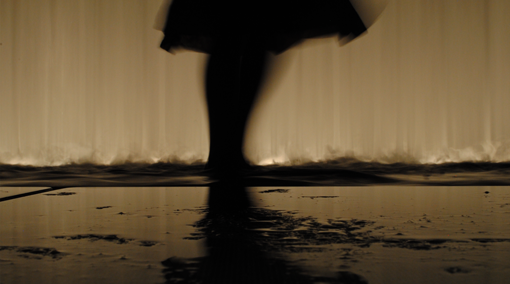Beyond Collaboration
Posted on December 12, 2010 | posted by:10 individuals. 1 choreographer. 2 musicians and a videographer converge for 50 minutes to explore the boundaries of various social norms, including public, private, community, individual, intimate, sexual, vulnerable, secure, suspicion and trust – The Partner Project/Scene in Public.
In a loose framework that oscillates between rehearsed and improvisational movement, four principal dancers including Rachel Lehrer, a fellow Transdisciplinary Design student, explore personal inadequacies while simultaneously wrestling with the complexities of partnership. Individual engagement is in constant check. At one point during the performance, Luke Gutgsell verbally solicits Rachel’s trust. Free falling into the air, Luke desperately beckons Rachel to rescue him. This test is repeated several times before Rachel reciprocates, letting gravity pull her to the floor, only to call for Luke at the very last moment.
After one and a half years of rehearsing, the dancers are not only speaking the same language, they are anticipating one another’s thoughts, desires and consequent movement. Considering the dancer’s movements are improvisational, what is the source of their synchronicity?
Is it consciousness?
Straddling the Jungian realms of conscious and unconscious.
Is it self-confidence?
As suggested by Tim Brown of IDEO, ideally collaborations include “individuals who are confident enough of their expertise that they are willing to go beyond it.(Change By Design, 27)”
Is it relinquishing the ego?
Lévanis’ proposes, “In understanding this being, I simultaneously tell him my understanding (Entre Nous, 7).”
Is it empathy?
As Kelly Tierney postulates in her post, Our Neighbors, Ourselves, “Could it be that meaningful empathy is most likely achieved by intervening in an ongoing rivalry before it shifts and corrupts behaviors. It may also be that a key to creating empathy that is acted upon is to reveal unhealthy rivalries and schadenfreude for what they are. By pulling back the curtain and revealing our behaviors we may help make permanent shifts in how people view the well being of ‘their neighbor’ and their community.”
Is it hierarchy?
Has the choreographer, Risa Jaroslow, embraced the Vygotskyian model of development by fabricating a scaffold upon which the dancers can ascend?
Or is it 1-1/2 years of dialogue, movement, pain, sweat and a variety of other factors, including those listed above, that coalesce into a 50 minute performance in which the dancers struggle unbeknownst to the audience to appear effortless?
Either way, sharing a few moments of their journey was an amazing gift. Many thanks Rachel.
…
